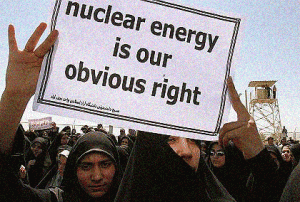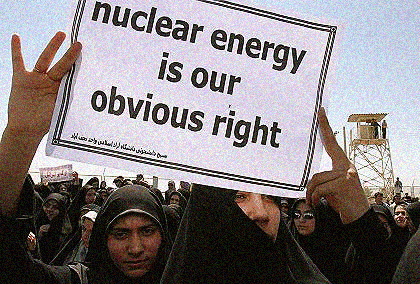 Why is the New York Times claiming the laws of physics are different in Iran then they are anywhere else? Well, the tip off to that answer is the word “Iran.”
Why is the New York Times claiming the laws of physics are different in Iran then they are anywhere else? Well, the tip off to that answer is the word “Iran.”
First, a few basics:
The thing about physics is that it is black and white: things happen or they don’t. Want to live forever? The Second Law of Thermodynamics says, nope, can’t do that (unless you can get rid of entropy, and you can’t). Want to rocket off to the nearest star a la Star Trek? Well, okay, but it is going to take a really, really long time to get there because you can’t go faster than the speed of light (and inertia would kill you long before you got close to 186,000 miles per second).
Back to the Times.
For the past several weeks the Times has been claiming that Iran is very close to producing weapons-ready nuclear fuel. On Jan. 23, Steven Erlanger, in an article entitled “Talks on Iran’s Nuclear Program Close With No Progress,” wrote that Iran is stepping up its production of enhanced uranium and has “enriched about 90 pounds of it to 19.75 percent, which is more than halfway to the level required for a bomb.”
Not close. Again, a little physics.
Uranium occurs naturally as U-238. In order to make a bomb you have to turn U-238 into U-235 or Plutonium 239. “Enrichment” is used for a lot of things besides obliterating cities. Uranium enhanced to 3 percent can run a power plant. Uranium enhanced to 19.75 percent can be used for medical purposes, like zapping cancer. For a nuclear weapon, however, uranium must be enhanced to between 80 percent and 90 percent.
Virtually all nuclear warheads currently use uranium that is 90 percent enhanced, although it is possible to produce a weapon with as little as 80. To detonate a weapon using U-235, all you need to do is blast two pieces of sub-critical fuel into one another. Two sub-criticals equal one critical, you achieve “fission” and a really big “bang!” The so-called “nuclear gun” is virtually foolproof and was the design of the Hiroshima bomb. In fact scientists were so confident it would work that they never bothered to test it.
Plutonium is trickier. The “gun” method doesn’t work because of the unique properties of Pu-239. You have to wrap plutonium with an explosive, and then implode it. The result is called “fusion.” The Nagasaki bomb (Fat Man) was composed of both U-235 and Pu-239, and it was the device that was tested at White Sands New Mexico in 1945. Today almost all nuclear weapons in the world are fusion devices, because fusion is more efficient than fission.
The Hiroshima bomb carried 64.1 kg of U-235 enhanced to 80 percent. The South Africans also produced at least six nuclear weapons that worked on the “gun” model, and those were enhanced to between 80 percent and 93 percent. The greater the enhancement, the less fuel you have to use. U-235 makes a perfectly serviceable nuke, but plutonium gives you more bang for the buck. The Department of Energy estimates that you can make a small nuclear weapon with a little as 4 kg of plutonium, and some scientists say you can make a nuke with as little as 1 kg of plutonium.
Keep in mind what they mean by “small.” The Hiroshima bomb—“Little Boy”—had an explosive force of between 12 and 15 kilotons of TNT. It killed over 70,000 people in the initial blast, and more than 30,000 in the weeks and years that followed. Its fireball reached 6,000 degrees centigrade at ground zero, and it utterly destroyed 62,000 buildings. Today “Little Boy” would be considered a tactical nuclear weapon.
Here is “big”:
- The W76 warhead: 100 kt
- The B61 warhead: 350 kt
- The W88 warhead: 475 kt
- The B53 warhead: 9,000 kt
- The B41warhead: 25 megatons
- The Tsar Bomba (Russian): 50 megatons.
What the laws of physics tell us is that 19.75 percent enhancement is not even a quarter of the way toward producing fuel that could be turned into a weapon. It is not nice stuff, mind you. Do not hug a container of 19.75 percent fuel. Radiation poisoning is really not the way you want to go.
The problem with the Times’s error (and it was repeated several times in other articles) is that it makes it sound like the Iranians are on the threshold of producing weapons-grade fuel. By virtually every account, they are not. Even Israeli military intelligence says Teheran is not currently working on producing a nuclear weapon, although it adds that Iran could produce the requisite fuel within two years if it wanted to.
According to Agence France Presse, Israeli Brigadier General Aviv Kochavi told the Knesset’s foreign affairs and defense committee that “it was unlikely that Iran, which currently enriches uranium to 20 percent, would start enriching it to the 90 percent level needed for a bomb, because it would be an open breach of the Nuclear Non-Proliferation Treaty, exposing it to harsher sanctions or even a U.S. or Israeli military strike.”
But the Times has Teheran more than halfway there—providing you ignore those annoying laws of physics. It is one thing to get someone’s name wrong, or misspell a word. Getting things about nuclear weapons wrong can have very dire consequences in the real world.
The Jerusalem Post reports that Israel has just acquired a new mid-air fuel tanker from the U.S. that would make an attack on Iran easier. The Israeli daily Ha’aretz says the Israeli Prime Minister Binyamin Netanyahu and his defense secretary Ehud Barak are seriously considering a strike at Iran. And according to UPI, the new Israeli chief of staff, Lt. Gen. Yoav Galant, also favors attacking Iran. If Iran is “more than half way to the level required for a bomb,” why not?
In the real world bad science has the potential to produce dangerous politics.
More of Conn Hallinan’s work can be found at Dispatches From the Edge.

